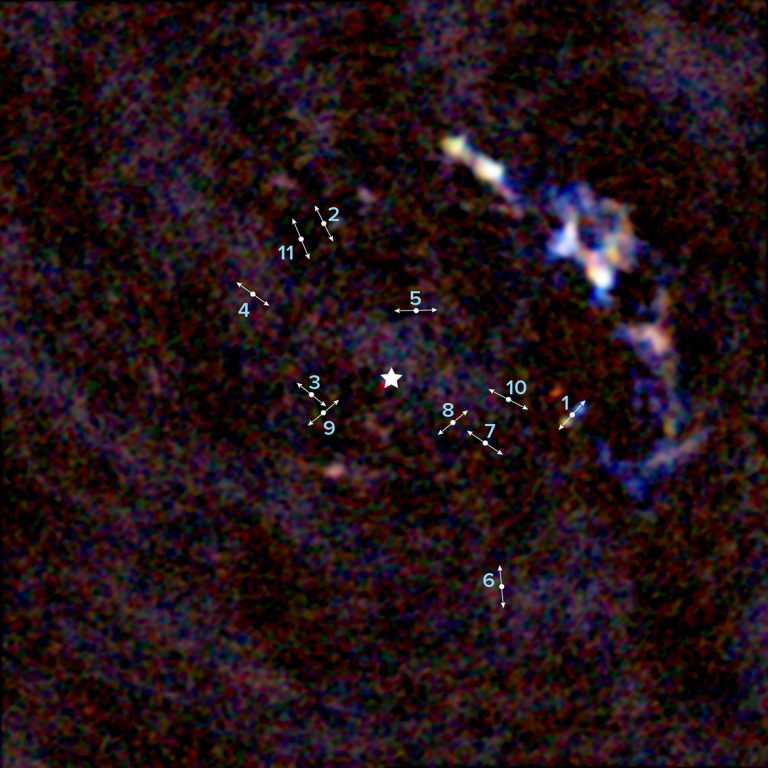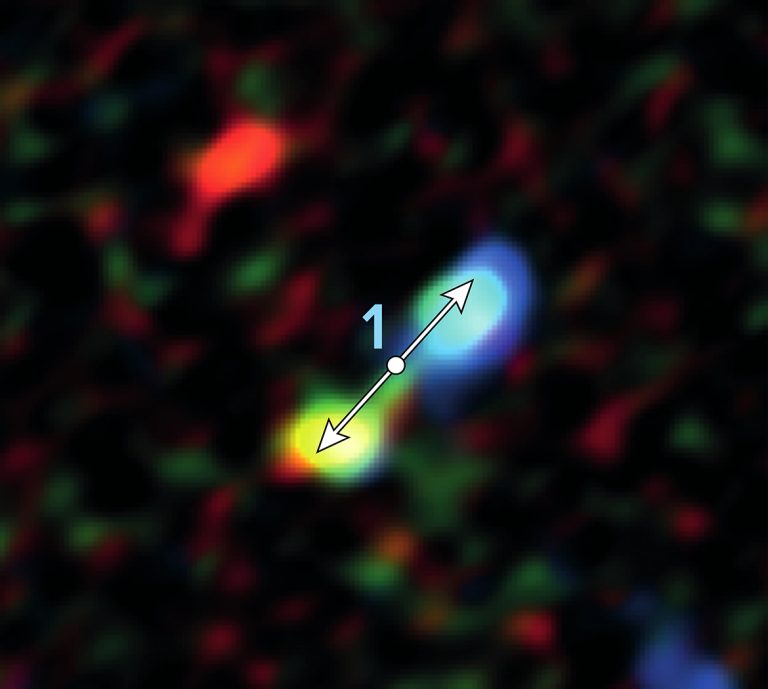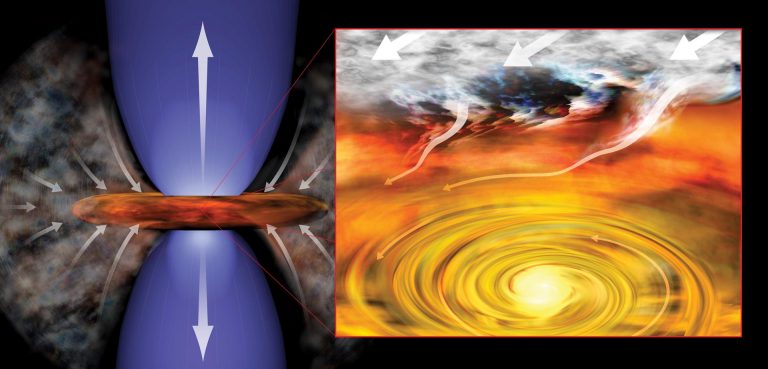At the center of our galaxy, in the immediate vicinity of its supermassive black hole , is a region wracked by powerful tidal forces and bathed in intense ultraviolet
, is a region wracked by powerful tidal forces and bathed in intense ultraviolet light and X-ray radiation. These harsh conditions, astronomers surmise, do not favor star formation, especially low-mass stars like our sun. Surprisingly, new observations from the Atacama Large Millimeter/submillimeter Array (ALMA) suggest otherwise.
light and X-ray radiation. These harsh conditions, astronomers surmise, do not favor star formation, especially low-mass stars like our sun. Surprisingly, new observations from the Atacama Large Millimeter/submillimeter Array (ALMA) suggest otherwise.
ALMA has revealed the telltale signs of eleven low-mass stars forming perilously close — within three light-years — to the Milky Way’s supermassive black hole, known to astronomers as Sagittarius A*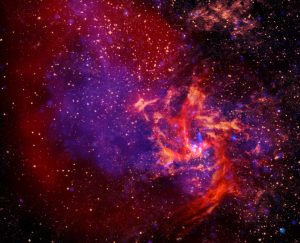 (Sgr A*). At this distance, tidal forces driven by the supermassive black hole should be energetic enough to rip apart clouds of dust and gas before they can form stars.
(Sgr A*). At this distance, tidal forces driven by the supermassive black hole should be energetic enough to rip apart clouds of dust and gas before they can form stars.
The presence of these newly discovered protostars (the formative stage between a dense cloud of gas and a young, shining star) suggests that the conditions necessary to birth low-mass stars may exist even in one of the most turbulent regions of our galaxy and possibly in similar locales throughout the universe.
The results are published in the Astrophysical Journal, Letters.
“Despite all odds, we see the best evidence yet that low-mass stars are forming startlingly close to the supermassive black hole at the center of the Milky Way,” said Farhad Yusef-Zadeh, an astronomer at Northwestern University in Evanston, Illinois, and lead author on the paper. “This is a genuinely surprising result and one that demonstrates just how robust star formation can be, even in the most unlikely of places.”
The ALMA data also suggest that these protostars are about 6,000 years old. “This is important because it is the earliest phase of star formation we have found in this highly hostile environment,” Yusef-Zadeh said.
The team of researchers identified these protostars by seeing the classic “double lobes” of material that bracket each of them. These cosmic hourglass-like shapes signal the early stages of star formation. Molecules, like carbon monoxide (CO), in these lobes glow brightly in millimeter-wavelength light, which ALMA can observe with remarkable precision and sensitivity.
Protostars form from interstellar clouds of dust and gas. Dense pockets of material in these clouds collapse under their own gravity and grow by accumulating more and more star-forming gas from their parent clouds. A portion of this infalling material, however, never makes it onto the surface of the star. Instead, it is ejected as a pair of high-velocity jets from the protostar’s north and south poles. Extremely turbulent environments can disrupt the normal procession of material onto a protostar, while intense radiation — from massive nearby stars and supermassive black holes — can blast away the parent cloud, thwarting the formation of all but the most massive of stars.
The Milky Way’s galactic center, with its 4 million solar mass black hole, is located approximately 26,000 light-years from Earth in the direction of the constellation Sagittarius. Vast stores of interstellar dust obscure this region, hiding it from optical telescopes. Radio waves, including the millimeter and submillimeter light that ALMA sees, are able to penetrate this dust, giving radio astronomers a clearer picture of the dynamics and content of this hostile environment.
Prior ALMA observations of the region surrounding Sgr A* by Yusef-Zadeh and his team revealed multiple massive infant stars that are estimated to be about 6 million years old. These objects, known as proplyds, are common features in more placid star-forming regions, like the Orion Nebula. Though the galactic center is a challenging environment for star formation, it is possible for particularly dense cores of hydrogen gas to cross the necessary threshold and forge new stars.
The new ALMA observations, however, revealed something even more remarkable, signs that eleven low-mass protostars are forming within 1 parsec – a scant 3 light-years – of the galaxy’s central black hole. Yusef-Zadeh and his team used ALMA to confirm that the masses and momentum transfer rates – the ability of the protostar jets to plow through surrounding interstellar material – are consistent with young protostars found throughout the disk of our galaxy.
“This discovery provides evidence that star formation is taking place within clouds surprisingly close to Sagittarius A*,” said Al Wootten with the National Radio Astronomy Observatory in Charlottesville, Virginia, and co-author on the paper. “Though these conditions are far from ideal, we can envision several pathways for these stars to emerge.”
For this to occur, outside forces would have to compress the gas clouds near the center of our galaxy to overcome the violent nature of the region and allow gravity to take over and form stars. The astronomers speculate that high-velocity gas clouds could aid in star formation as they force their way through the interstellar medium. It is also possible that jets from the black hole itself could be plowing into the surrounding gas clouds, compressing material and triggering this burst of star formation.
“The next step is to take a closer look to confirm that these newly formed stars are orbited by disks of dusty gas,” concluded Mark Wardle, an astronomer at Macquarie University in Sydney, Australia, and co-investigator on the team. “If so, it’s likely that planets will eventually form from this material, as is the case for young stars in the galactic disk.”
The National Radio Astronomy Observatory is a facility of the National Science Foundation, operated under cooperative agreement by Associated Universities, Inc.
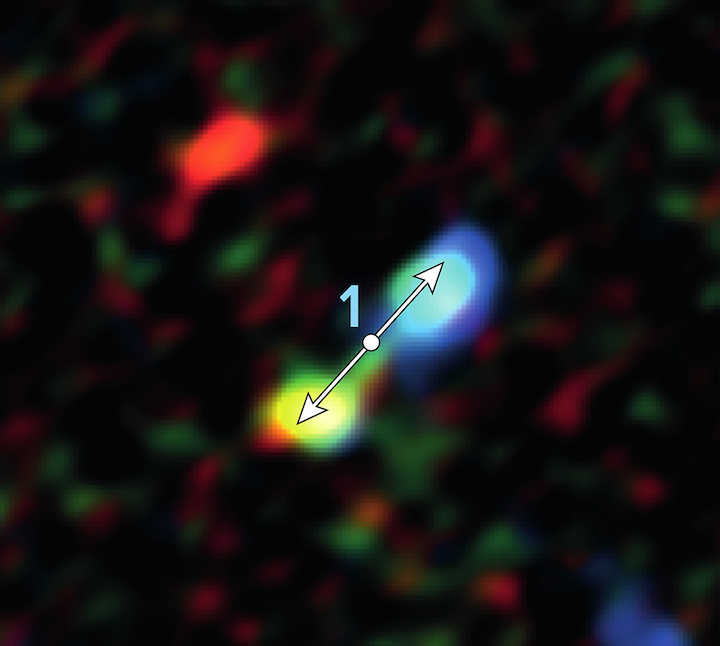

# # #
This research is presented in a paper titled “ALMA Detection of Bipolar Outflows: Evidence for Low Mass Star Formation within 1pc of Sgr A*,” by F. Yusef-Zadeh, et al., appearing in the Astrophysical Journal Letters [https://doi.org/10.3847/2041-8213/aa96a2].
This work is partially supported by the grant AST-0807400 from the National Science Foundation.
The Atacama Large Millimeter/submillimeter Array (ALMA), an international astronomy facility, is a partnership of the European Organisation for Astronomical Research in the Southern Hemisphere (ESO), the U.S. National Science Foundation (NSF) and the National Institutes of Natural Sciences (NINS) of Japan in cooperation with the Republic of Chile. ALMA is funded by ESO on behalf of its Member States, by NSF in cooperation with the National Research Council of Canada (NRC) and the Ministry of Science and Technology (MOST) in Taiwan and by NINS in cooperation with the Academia Sinica (AS) in Taiwan and the Korea Astronomy and Space Science Institute (KASI).
ALMA construction and operations are led by ESO on behalf of its Member States; by the National Radio Astronomy Observatory (NRAO), managed by Associated Universities, Inc. (AUI), on behalf of North America; and by the National Astronomical Observatory of Japan (NAOJ) on behalf of East Asia. The Joint ALMA Observatory (JAO) provides the unified leadership and management of the construction, commissioning and operation of ALMA.
The team is composed of F. Yusef-Zadeh (Northwestern University), M. Wardle (Macquarie University), D. Kunneriath (National Radio Astronomy Observatory), M. Royster (Northwestern University), A. Wootten (National Radio Astronomy Observatory), and D.A. Roberts (Northwestern University).
